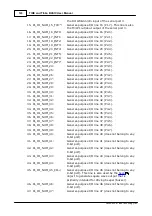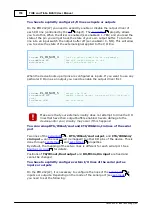
147
TIDE and Tibbo BASIC User Manual
©2000-2008 Tibbo Technology Inc.
Will auto-
configure as
output
(1)
Will auto-
configure
as input
(1)
Requires
configurati
on as
output
(2)
Requires
configuratio
n as input
(2)
Requires
configuratio
n as output
Requires
configuratio
n as input
Notes:
1. When This line does not require configuration, it will be configured
automatically as input or output when the port is opened. When the port is
closed the line will return to the input/output and high/low state it had before
the port was opened.
2. Please, remember that you need to configure the I/O pin to which this line of the
serial port is currently mapped.
Each serial port has 16 bytes of send FIFO
mode (
= 0- PL_SER_MODE_UART,
= 0- PL_SER_SI_FULLDUPLEX, and
= 1- ENABLED) the device is monitoring its CTS input to see if
attached serial device is ready to receive more data. If the CTS state changes to
"cannot transmit" the device will stop sending out data immediately. However, the
data that has already entered the FIFO will still be sent out. Therefore, after the
CTS state becomes "cannot transmit" the device can still send out up to 16
characters.
There is a PLL
On the EM1000(W) there is a PLL that, when switched on, increases the main clock
of the device 8-fold (power cosumption also increases roughly by as much). When
the PLL is off, the clock frequency of the device is 11.0592MHz; when the PLL is on
the clock frequency is 88.4736MHz.
The clock frequency affects all aspects of device operation that rely on this clock.
Naturally, program execution speed depends on the clock frequency. Additionally,
the baudrates of the
property)
depend on the main clock. Finally, the frequency of the square wave generated by
the
object depends on the main clock as well.
object has a
read-only property and
method. See
topic- it explains how to switch PLL
on and off.
) the EM1000 boots with the PLL on or
off depending on the state of the PE pin.
For the serial port, there is a way to set the baudrate in the clock-independent
(and, actually, platform-independent) way -- see
property for
details (example of use can be found in the
topic). For the beep
object, you just have to set the
correctly depending on the value
returned by the sys.currpll property.
Data in the special configuration section of the EEPROM
Bottom 8 bytes of the EEPROM (accessible through the
object) are reserved
226
229
232
224
226
255
255
253
224
248
387
212
218
219
215
222
250
224
388
380
















































